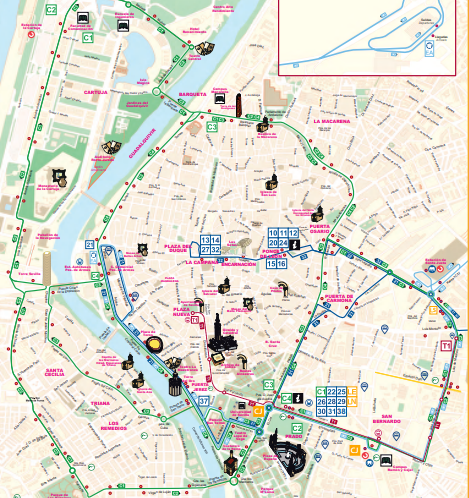Seville Guide
Navigating Seville: A guide to pubic transport
To fully appreciate Seville’s many attractions, tourists need a reliable and efficient way to get around. Fortunately, Seville’s public transport system is both extensive and user-friendly. This guide will help you navigate the city with ease, using buses, trams, metro, and bicycles.
1. TUSSAM Buses
Seville’s bus network, operated by Transportes Urbanos de Sevilla (TUSSAM), is one of the most comprehensive ways to get around the city. With over 40 routes covering the entire city, buses are an excellent option for reaching places not accessible by metro or tram.
Key Points:
- Routes and Timetables: Bus routes are numbered and color-coded, with information available at bus stops and on the TUSSAM website or app. Some key routes for tourists include:
o C1 and C2: Circular routes that loop around the city center.
o EA: Connects Seville Airport with the city center, stopping at major transport hubs.
o C3 and C4: Inner city loops passing through important areas like Triana and Macarena. - Tickets and Fares: Single tickets cost around €1.40 and can be purchased on the bus. For multiple trips, the Tussam travel card (Tarjeta Multiviaje) offers significant savings. You can also use the rechargeable Consorcio de Transportes card, valid for buses, metro, and trams.
- Night Buses: Known as Búhos (Owls), night buses operate on weekends and public holidays, ensuring safe travel after dark. Routes N1 to N9 cover different parts of the city.
2. Metro
The Seville Metro, although limited compared to those in larger cities, is a fast and efficient way to travel, especially during peak hours. Currently, the metro consists of a single line (Line 1), with plans for expansion.
Key Points:
- Route: Line 1 runs from Ciudad Expo in the west to Olivar de Quintos in the east, passing through key areas like Puerta de Jerez (near the historic center), San Bernardo, and Nervión.
- Tickets and Fares: Tickets can be purchased at machines in metro stations. A single journey costs around €1.35 to €1.80, depending on the zones traveled. The rechargeable Consorcio de Transportes card can also be used on the metro, offering convenience and discounts.
- Frequency: Trains run approximately every 5-7 minutes during peak times and every 8-10 minutes off-peak. The metro operates from 6:30 a.m. to 11 p.m. (midnight on Fridays and Saturdays).
3. Trams (MetroCentro)
Seville’s tram system, known as MetroCentro, is a convenient way to travel within the historic center. The tram line runs from Plaza Nueva to San Bernardo, providing easy access to many of Seville’s main attractions.
Key Points:
- Route: The tram covers key locations, including Plaza Nueva, Archivo de Indias, the Cathedral, and San Bernardo (connecting with the metro and train station).
- Tickets and Fares: Tram tickets cost the same as bus tickets and can be bought at tram stops or using the TUSSAM or Consorcio cards.
- Frequency: Trams run every 5-10 minutes, making them a reliable option for short trips within the city center.
4. Cercanías (Suburban Trains)
Seville’s Cercanías trains are ideal for exploring the outskirts of the city and nearby towns. Operated by Renfe, these suburban trains connect Seville with places like Dos Hermanas, Utrera, and Carmona.
Key Points:
- Routes: There are six lines (C1 to C5 and C7), with C1 and C4 being particularly useful for tourists. C1 runs from Lebrija to Lora del Río, while C4 is a circular line around Seville.
- Tickets and Fares: Tickets can be bought at stations. Prices vary depending on the distance traveled. The Renfe & Tú card is a rechargeable option for regular users.
- Frequency: Trains run frequently, with intervals of 15-30 minutes during peak times.
5. Taxis
While public transport is comprehensive, taxis provide a convenient option for more direct routes or late-night travel.
Key Points:
- Availability: Taxis can be hailed on the street, found at taxi ranks, or booked by phone or apps like Cabify and MyTaxi. They are white with a yellow stripe.
- Fares: Taxis use meters, with fares starting at around €3.50, plus additional charges for luggage, airport trips, or night rides. Credit cards are widely accepted.
6. Sevici (Bike Sharing)
Seville is a bike-friendly city, with numerous bike lanes and a popular bike-sharing system called Sevici. This is an excellent way to explore the city at your own pace.
Key Points:
- How It Works: Sevici bikes are available at numerous stations throughout the city. You can subscribe for a short-term pass (7 days) or a long-term subscription.
- Cost: A weekly pass costs around €13.33, with the first 30 minutes of each ride free. Additional time incurs a small fee.
- Stations: Bike stations are conveniently located near major attractions and transport hubs. Bikes can be picked up and dropped off at any station.
Seville’s public transport system is well-designed to cater to both locals and tourists, offering a variety of options to explore the city efficiently. Whether you’re hopping on a bus to visit the Alcázar, taking the metro to the bustling Nervión district, or enjoying a leisurely bike ride along the Guadalquivir River, understanding how to navigate Seville will enhance your experience and ensure you don’t miss any of the city’s spectacular sights. With this guide, you’re well-equipped to explore Seville’s rich cultural tapestry and vibrant atmosphere with ease and confidence.
Related articles
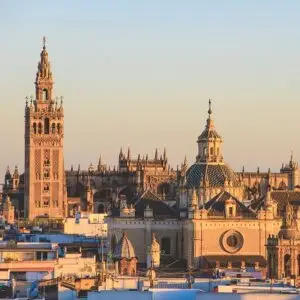
Top 10 places to visit in Seville
Seville could be described as a grand city. The architects of its cathedral are famed to have said “Let’s build
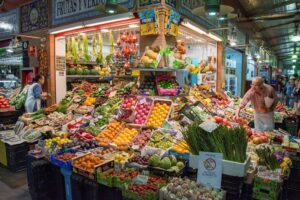
Hidden gems in Seville: off the tourist track
Seville, the sun-drenched capital of Andalucía, is famed for its flamenco, tapas, and stunning Moorish architecture. While landmarks like the
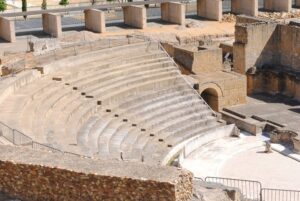
10 day trips from Seville you should not miss
A visit to the city of Seville offers plenty to see, but if you have more than a few days
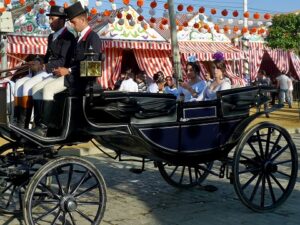
The vibrant fiestas of Seville: culture, tradition & joy
What truly sets Seville apart are its vibrant fiestas. These celebrations, deeply rooted in tradition, offer visitors a unique glimpse

